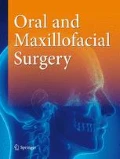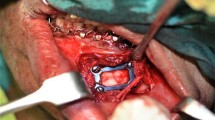Abstract
Background
The main goal of treatment of mandibular fractures is to restore normal dental occlusion and promote appropriate bone healing and a normal mouth opening. Recently, there has been a resurgent interest in the use of screws for intermaxillary fixation of mandibular fractures. This study was therefore designed to determine how the clinical outcomes of the use of screws for intermaxillary fixation compare with the use of miniplates in the treatment of mandibular fractures in Nigeria.
Objectives
The objectives of this study are as follows:
-
1.
To compare the clinical outcomes of the use of 2.0 mm × 9.0 mm screws for intermaxillary fixation with 2.0 mm noncompression miniplates in the treatment of simple unilateral mandibular fractures in Lagos, Nigeria
-
2.
To determine the clinical outcomes in the use of 2.0 mm × 9.0 mm screws for intermaxillary fixation (IMF) and 2.0 mm noncompression miniplates in the treatment of simple unilateral mandibular fractures
-
3.
To compare the complications associated with the use of 2.0 mm × 9.0 mm screws for IMF and 2.0 mm noncompression miniplates in the treatment of mandibular fractures
Methodology
This randomized controlled clinical study was carried out at the Department of Oral and Maxillofacial Surgery of the study institution. Subjects with simple unilateral mandibular fractures who met the inclusion criteria were randomly allocated into the study (intermaxillary fixation screw) and control (miniplate) groups through balloting. Factors assessed and compared during and after the procedures included intraoperative pain, postoperative nerve impairment, postoperative occlusion, limitation of mouth opening, incidence of hardware failure, incidence of infection and non-union. Data was analysed using the Statistical Package for Social Sciences (SPSS) version 20.
Results
A total of 56 subjects participated in the study, with 28 subjects in each group. Majority (91%) of the subjects were male. Road traffic crash was the highest aetiological factor while sport was the least (3.6%). A higher proportion (25.0%) of subjects in the miniplate group had major complications compared with 14.3% in the IMF screw group. There was no statistically significant association between site of mandibular fracture, time elapsed before treatment and complications (p < 0.05). All cases of mandibular fractures healed successfully at 6 weeks.
Conclusion
The use of screws for IMF is as effective as 2.0 mm noncompression miniplates in the treatment of simple unilateral mandibular fractures.









Similar content being viewed by others
References
Hendler BH (1998) Maxillofacial trauma. In: Rosen P (ed) Emergency medicine concepts and clinical practice. Mosby, St Louis, pp 1093–1003
Fasola AO, Nyako AE, Obiechina EA, Arotiba JT (2003) Trends in the characteristics of maxillofacial fractures in Nigeria. J Oral Maxillofac Surg 61:1140–1143
Gassner R, Tuli T, Hächl O, Rudisch A, Ulmer H (2003) Cranio-maxillofacial trauma: a 10 year review of 9543 cases with 21067 injuries. J Cranio- maxillofac Surg 31:51–61
Banks P, Brown A (2001) Fractures of the facial skeleton, 2nd edn. MPG Books Ltd, Cornwall, pp 7–81
Okoturo E, Arotiba GT, Akinwande JA, Ogunlewe MO, Gbotolorun O (2008) A comparative study of mandibular fracture treatment using maxillomandibular fixation and miniplate osteosynthesis. J Oral and Maxillofac Surg 7(3):307–310
Martinez-Gimeno C, Acero-Sanz J, Martin-Sastre R, Navarro-Villa C (1992) Maxillofacial trauma: influence of HIV infection. J Craniomaxillofac Surg 20:297–202
Hamid MH, Parhiz A (2012) Complications using intermaxillary fixation screws. J Oral Maxillofac Surg 69:1411–1414
Kumar N, Satish K (2011) IMF screws as an alternative to arch bar fixation in management of mandibular fracture. Int J of Dent Clin 3:82–83
Ivy RH, Curtis L (1926) Fractures of the mandible: an analysis of 100 cases. Dental cosmos 68:439
Adebayo ET, Ajike OS, Adekeye EO (2003) Analysis of the pattern of maxillofacial fractures in Kaduna. Nigeria Br J Oral Maxillofac Surg 41(6):396–400
Anyanechi CE, Saheeb BD (2011) Mandibular sites prone to fracture: analysis of 174 cases in a Nigerian tertiary hospital. Ghana Medical J 45(3):111–114
Blitz M, Notarnicola K (2009) Closed reduction of mandibular fracture. Atlas Oral Maxillofac Surg Clin N Am 17:1–13
Khan A, Khitab U, Khan TM, Salam A (2010) A comparative analysis of rigid and non rigid fixation in mandibular fractures: a prospective study. Pak Oral Dent J 30(1):63
Moreno JC, Fernadez A, Ortiz JA, Montalvo JJ (2000) Complication rates associated with different treatments for mandibular fractures. J Oral Maxillofac Surg 58:273–280
Okoturo EM, Arotiba GT, Akinwande JA, Ogunlewe MO, Gbotolorun OM, Obiechina AE (2008) Miniplate osteosynthesis of mandibular fractures at the Lagos University Teaching Hospital. Nig Qt J Hosp Med 18(1):45–49
Banks P, Killey HC (1991) Killey’s fractures of the mandible, 4th edn. Wright, England, p 127
Rai A, Datarkar A, Borle RM (2011) Are maxillomandibular fixation screws a better option than Erich arch bars in achieving maxillomandibular fixation? A randomized clinical study. J Oral Maxillofac Surg 69:3015
West GH, Griggs JA, Chandran R, Precheur HV, Buchanan W, Caloss R (2014) Treatment outcomes with the use of maxillomandibular fixation screws in management of mandible fractures. J Oral Maxillofac Surg 72:112–120
Coburn DG, Kennedy DW, Hodder SC (2002) Complications with intermaxillary fixation screws in management of fractured mandible. Br J Oral Maxillofac Surg 40:241
Prein J, Rahn BA (1998) Scientific and technical background. In: Prein J (ed) Manual of internal fixation in the cranio-facial skeleton: techniques recommended by the AO/ASIF Maxillofacial Group. Springer –Verlag, Berlin, pp 1–49
Coletti DP, Salama A, Caccamese JF Jr (2007) Application of intermaxillary fixation screws in maxillofacial trauma. J Oral Maxillofac Surg 65:1746
Cornelius C, Ehrenfeld M (2010) The use of MMF screws: surgical techniques, indications, contraindications, and common problems in review of literature. Craniomaxillofac Trauma Reconstr 3(2):55–80
Lamphier J, Zicardi V, Ruvo JM (2003) Complication of mandibular fractures in an urban teaching center. J Oral Maxillofac Surg 61:166–173
Barker DA, Oo KK, Allak A, Park S (2011) Timing for repair of mandible fractures. Laryngoscope 121:1160–1163
Biller JA, Pletcher SD, Goldberg AN, Murr AH (2005) Complications and the time to repair mandible fractures. Laryngoscope 115:769–772
Author information
Authors and Affiliations
Corresponding author
Ethics declarations
Approval for the study was obtained from the Health Research and Ethics Committee of the Lagos State University Teaching Hospital, Ikeja, Lagos State.
Rights and permissions
About this article
Cite this article
Anslem, O., Eyituoyo, O., Olabode, O.V. et al. A comparative study of intermaxillary fixation screws and noncompression miniplates in the treatment of mandibular fractures: a prospective clinical study. Oral Maxillofac Surg 21, 233–240 (2017). https://doi.org/10.1007/s10006-017-0622-5
Received:
Accepted:
Published:
Issue Date:
DOI: https://doi.org/10.1007/s10006-017-0622-5




